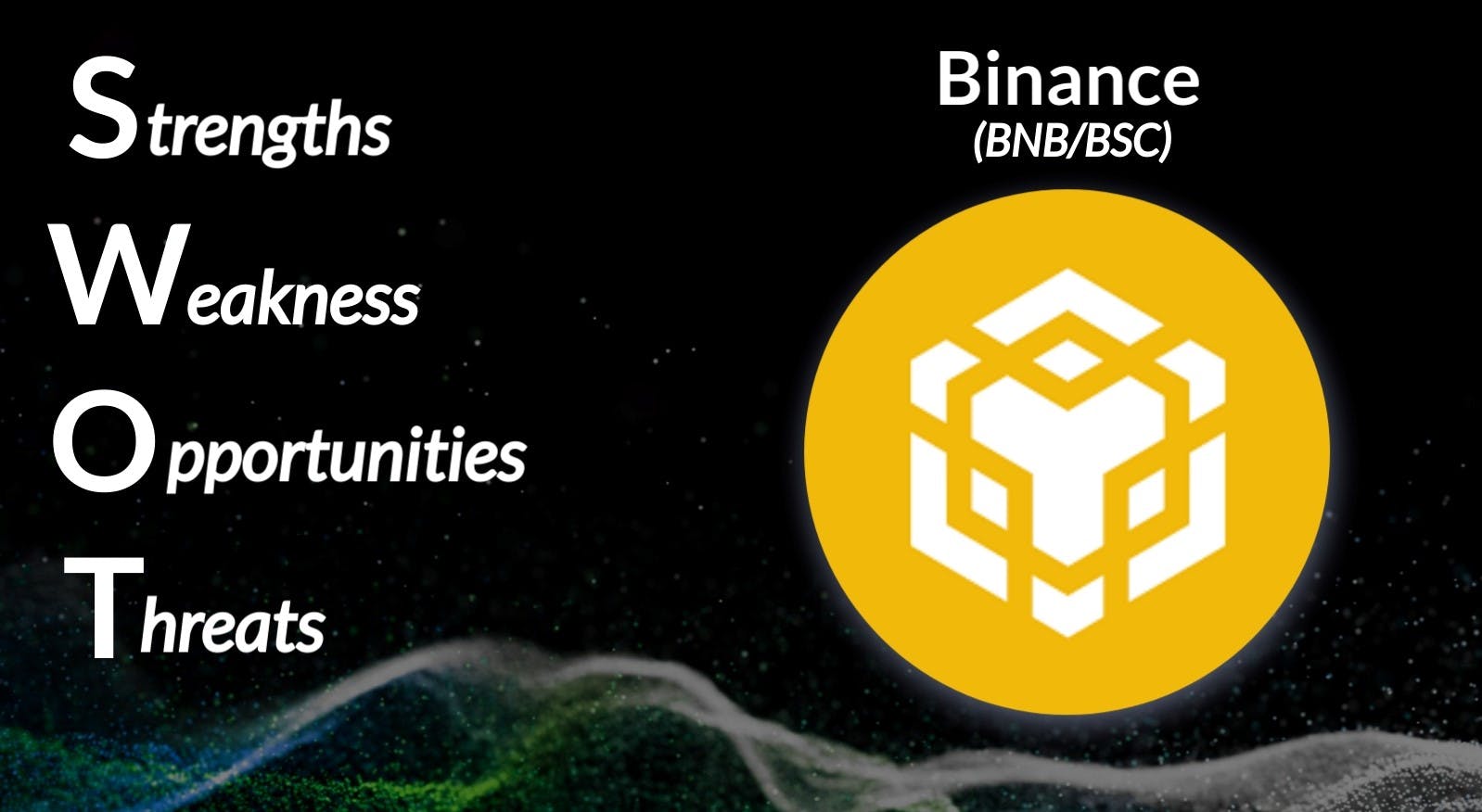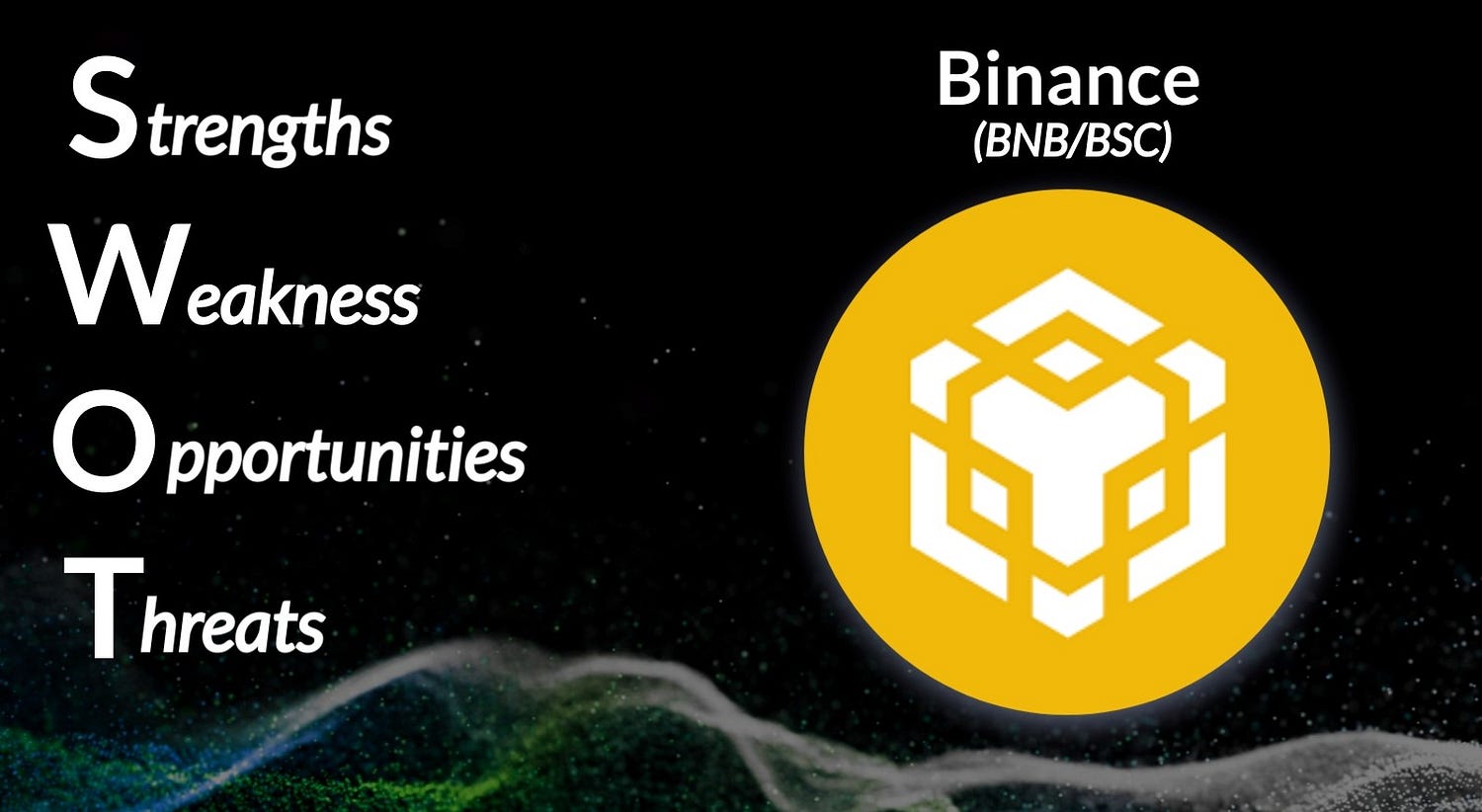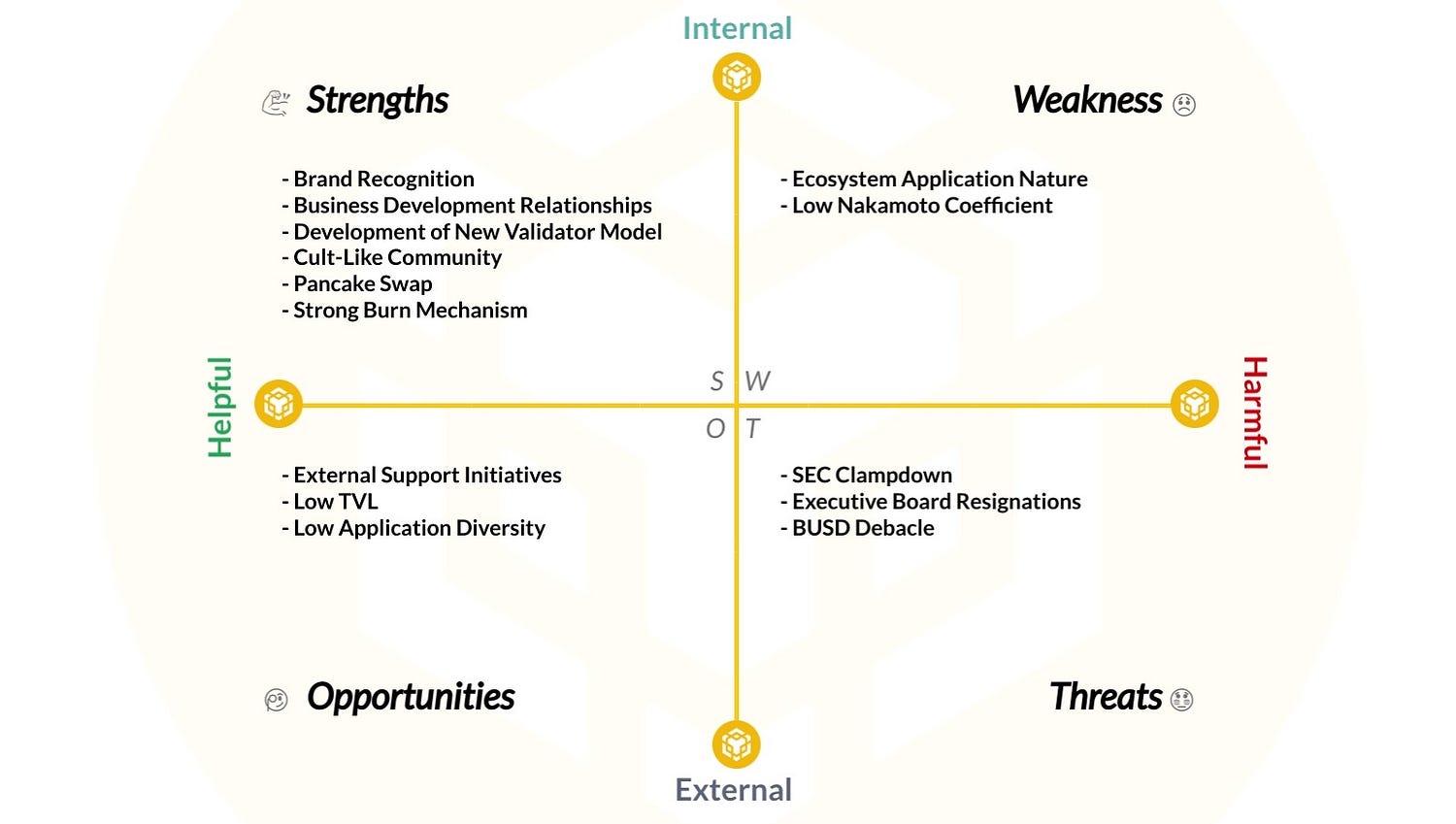
SWOT Analysis: BNB Chain (BSC)
*Note: a SWOT analysis is an evaluation of the fundamental, operational, technical, social, economic, and even to some degree administrative elements of a project. This is not a model to be used for trading purposes. (NFA, DYOR)

Composed of four elements, Strengths, Weaknesses, Opportunities, and Threats, a SWOT analysis framework provides excellent insight for establishing a high-level understanding of the state of a project’s well-being through the lens of a birds-eye view.
It can help formulate decisions around which areas require more attention, set performance goals, and organize a foundational understanding of where a project is headed.
Rarely (if ever) used in crypto, it is time to apply this timeless method of evaluation to the digital asset space.
Today, Binance Chain (BNB), a domineering brand in Web3 and a multi-chain blockchain framework composed of an EVM-compatible layer 1, decentralized storage, consensus, and scalability sidechains, will get a SWOT.

💪 Strengths (Internal) (Helpful)
1. Brand Recognition
Binance is the most popular brand in crypto, blockchain, and Web3 on the scale of global retail. For nearly every sector of crypto, from centralized and decentralized exchanges to gambling and wallets, Binance is the best-recognized black and yellow brand. From Russia to China, to Singapore, to the UAE, and everywhere in between, Binance reigns supreme. For years, the consistency of interweaving BNB into every cultural aspect of crypto (such as Bitcoin Pizza Day, where Binance makes BNB branded goodies; or shooting well thought out social videos of black and yellow Lambos) has transformed the project into one associated with the very foundings of crypto on the world stage as we know it today.
2. Business Development Relationships
Binance’s business development is second to none. They negotiate well, build strong, life-long relationships, and understand who they must be building with. Recently, Layer Zero has proven to be infinitely valuable to Binance as they brought so much new on-chain activity (roughly ~25% of transactions are attributable to Layer Zero’s integration of Stargate). Beyond the technological, Binance has built incredible affiliations with world-class superstars such as Christiano Ronaldo (who hosted an NFT sale through Binance) and other non-crypto specific influencers that expand the scope of Binance beyond crypto and ultimately help the Web3 industry onboard new users.
3. Development of New Validator Model
Currently sitting at 29 validators (up from 24 the year before), Binance has begun to aggressively pursue the decentralization of its ecosystem with the implementation of BEP-131, BEP-153, and BEP-159. These three improvement proposals create a more favorable environment for the staking and validator selection mechanisms. Targeting to grow the set to 100 validators translates to a higher degree of asset and governance distribution; Ultimately creating a more resilient and equitable environment that is more robust to handle regulatory issues.
4. Cult-Like Community
Possibly bolstered through very sophisticated botnets, Binance is without a doubt one of (if not THE) crypto projects with a social presence full of the most die-hard extreme community members. From the brand itself, extending to the CEO (CZ), the community of BNB/BSC users is raving and supporting the ecosystem without worry of recourse. Few communities (besides Bitcoin) have such committed audiences that their involvement borders on insanity. Surely, this is a massive benefit to the project; they can basically weather any storm knowing there will be a foundational group of users that will evangelize BNB no matter what happens. While this may seem harsh or skeptic, it is obviously an expression of psychological mastery on behalf of the project product and marketing/community building efforts.
5. Pancake Swap
Pancake Swap originated as a DEX in the Binance ecosystem. Since its inception, it has grown to become a multi-chain tool (Ethereum, Linea, Base, Polygon, and many others). By becoming an important actor in facilitating on-chain exchange, Pancake Swap has accrued TVL over $1,300,000,000 USD. Considering the vast majority of that is attributable to Binance chain, Pancake Swap is holding roughly 30% of all the network’s liquidity. Certainly, that is a very high concentration, but it is lower than its previous levels of over 40%.
6. Strong Burn Mechanism
Burning has become of the few widely adopted economic modules for digital assets that exert tremendous supply-side pressure. While there are arguments regarding the exact implementations of it and whether or not the implications of it are properly effective, the six years of a burning mechanism present in BNB has removed ~46 million tokens from circulation, considering that the total max supply was 200 million, to begin with, that translates to nearly 25% of the entire supply being no longer available. When measuring against the token’s historic performance, and the anticipated perpetual burn rate of 1.1% year-on-year, burning might prove to be one of the most powerful forces for driving ecosystem growth over long enough time frames.
😞 Weaknesses (Internal) (Harmful)
1. Ecosystem Application Nature
Binance has defined itself as a powerful brand with high-quality features and a strong social presence. The external ecosystem of solutions that build on Binance, for some odd reason, predominately carry weak brands, lack the intellectual finesse present in other environments, and tend to lean to design principles that are, at the least to say, nonsensical. So many of the newer generation projects are primarily forks or trashy clones of other successful projects, don’t have a remote idea of a genuine, logical economic model, prey on the general stupidity of retail consumers, and do not appeal to first-world players. *I won’t name these projects because I have incredible respect for any founders that might just need more time to optimize themselves, but if you would just look at most launchpad projects or projects less than a year old on the BNB chain, you will find that 9/10 are idiotic; what’s more insane is that 8/10 will have raised money somehow…
2. Low Nakamoto Coefficient
Everybody should already understand that Binance is a centralized project. There is nothing wrong with centralized projects (except for, of course, the risks of malicious intentions that might be undesirable for end users and the fact that the SEC will have stronger cases to pursue some kind of legal recourse), but the main issue with Binance’s centralization is that they incessantly bill themselves as being decentralized. The Nakamoto coefficient is a rough measure of a network’s decentralization in terms of the threshold of validators that must be manipulated in order to overthrow the network. In the case of Binance (which has 29 validators), the Nakamoto coefficient is 8; ranking it at the very low end, teetering towards a higher degree of centralization.
🧐 Opportunities (External) (Helpful)
1. External Support Initiatives
Binance is possibly the most supportive layer one network for all of the projects that try to build on top of it. Hosting a multitude of hackathons, incubators, accelerators, grants, and bounty programs, Binance has attracted so many burgeoning ideas with its brilliant marketing and attractive incentives. Builder grants, Gas grants, MVB accelerator, Zero-2-Hero, Kickstart, and countless other initiatives are helping early-stage projects bootstrap themselves.
2. Low TVL
With around $3 Billion USD in total value locked across a small group of applications, the amount of value locked on chain is ~9x lower than the project’s market cap. The 1:9 ratio produces mixed signals (positive and negative); however, given the macro backdrop of declining global market values and TVL on every chain and platform, the current TVL foreshadows a potential explosion upwards, which would then likely exert positive pressure on all assets.
3. Low Application Diversity
With just a handful of applications dominating Binance chain by measures of value locked, volume produced, gas fees generated, and unique active addresses involved, there is a large gap in the market for better solutions to arrive on Binance’s network. Not long ago, Uniswap bridged to BSC, and yet Pancakeswap still holds an outsized portion of TVL. Given how much ecosystemic support Binance provides, it is highly likely (if not inevitable) that better products will eventually arrive and supercharge the ecosystem.
😳 Threats (External) (Harmful)
1. SEC Clampdown
In the second quarter of 2023, the SEC has thrown full force at the overall Binance ecosystem, claiming they have been engaging in illegal operations, including offering trading/sales of unregistered securities, including their own native BNB token. Contrary to traditional targeting, even the CEO of Binance has become a focal point of witch-hunting.
2. Executive Board Resignations
Starting way back in 2021 with the resignation of the Binance US CEO Cathy Coley, followed by the quick arrival and short-lived departure of Brian Brooks, directors for every department of the company have been jumping ship at an insane rate. Over the course of 2023 alone, more than 10 people with mission-critical roles in the organization have voluntarily stepped away from their positions. From product leads to marketing to strategy to compliance, have left the organization one after the other. While there could be (and have been arguments made for both sides of the situation), the loss of so many key people can easily spill over into massive operational friction that arises by not having the qualified professional talent helping steer the continuing evolution of the project. Now time and resources must be spent educating new people into these roles.
3. BUSD Debacle
Binance implemented its own stablecoin, BUSD (Binance USD), through the use of a trusted, regulated issuer, Paxos. Suddenly, in February of 2023, NYDFS (the New York Department of Financial Services) forced Paxos to halt its issuance of BUSD on the grounds that they will be sued by the government for dealing with an unregistered security. This single issue drained over $1 billion USD from Binance Chain’s stablecoin network value and allowed Tether to swoop in and become the dominant stablecoin on the network.
Takeaway:
From its humble beginnings as a crypto-to-crypto exchange that went live through an ICO back in 2017, Binance is one of the strongest brands in the entire industry. As it pertains to a crypto asset brand, Binance is, without a doubt, the Leader.
Being the leader means that you will attract a lot of attention, a lot of it good, the majority of it not so good.
Binance is flush with trash at the moment.
One thing that I cannot get over, it projects are raising money on a concept that does not need a token at all, but what's worse is that these degenerates put “Burning” as a token utility… Why would you give money to something stupid enough to consider burning a utility? Burning is a monetary policy to control the supply-side dynamics of a digital asset. Not a utility. I can rant about this for days, but let's just move on.
Besides the ecosystem of ghost projects, Binance continues to be a powerhouse in the industry. Regardless of whether you want to discuss the centralized exchange side or the “decentralized” blockchain ecosystem, Binance has made a permanent mark on the Crypto industry
Conclusion:
The current state of Binance is delicate… But I am cautiously optimistic.
The history of the project, its social acuity, intelligent leadership, effective marketing, and quality products all incline me to believe Binance will be here regardless of what the FUD may indicate in the near term.
All said and done, Binance is only suffering right now due to regulatory problems, in spite of which the platforms continue to operate, and (so far) all user funds have been SAFU.
The larger the problem Binance lives through, the more resilient it becomes to future events. Navigating its current problems would ultimately propel Binance into the “too-big-to-fail” caliber.
Would I personally invest in BNB?
Very, very carefully, and only through a DCA approach.
It seems having some BNB/BSC just to always have access to the network for bridging, emergency trading, or getting paid in stablecoins and then moving them elsewhere is such a no-brainer; in fact, that is probably best practice for overall being able to operate in Web3.
If you know something that I don’t or feel as though I might have missed anything worth noting, please do share, I would tremendously appreciate some feedback.
Thank you so much for reading,
I hope this serves you well on your journey.
Live long and prosper 🥂

